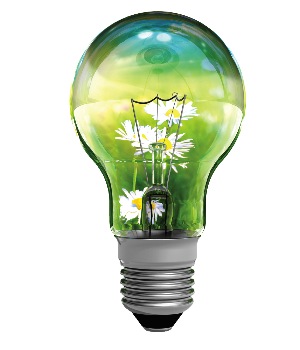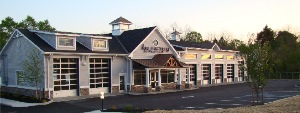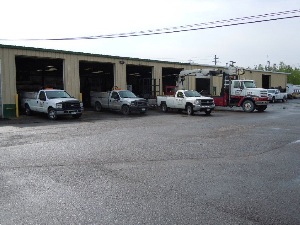Tree huggers may not have inherited the earth, but some of their philosophies have taken root in the business world.
What’s good for the environment, we’ve found in a time of limited resources and profits, is also good for the bottom line.  And now, staying in the black is linked with going green.
And now, staying in the black is linked with going green.
But there’s more than one way for tire dealerships to be environmentally conscious, economical and efficient. And those methods go beyond recycling, insulating or going paperless.
Increasing numbers of dealerships are utilizing significant new green initiatives to save money, as well as the world. Whether they involve wind turbines or high-efficiency lighting systems, solar panels or new materials, awareness campaigns or the complete rebuilding of their facilities, the methods may be the wave of a more healthy, abundant and profitable future.
The Big Picture
When Ed Perry decided to build a new facility for his dealership in Poughkeepsie, N.Y., he did more than open a new shop.
“We started with a burnt-out old warehouse covering all of the lot with impermeable concrete,” he says. “It had suffered a fire and was partially collapsed, sitting for years awaiting someone who could see the diamond-in-the-rough. It was overrun with pests, dangerous, and a gathering place for some undesirable social activity.”
What Perry ended up with was an aesthetically pleasing and highly green location for Arlington Auto and Tire that uses half the energy of its old facility, which, at eight bays, was half the size.
“I demolished the old building and recycled all the old concrete and steel,” he explains. “We graded up the land and installed groundwater recharging drainage systems, used only 20% of the lot for building coverage, and added a large amount of rainwater-permeable area with landscaping. The building was built with fire-resistant materials that are almost all totally recyclable, such as concrete siding, cultured stone and concrete walls and steel.
“Super-efficient window lighting (installed high in the shop’s bays so lights can often be turned off) and LED lighting were used, and a rotary compressor system further reduced electrical usage,” he adds. “We recycle waste oil into heat during the winter and send it for proper recycling in summer months. Our quick oil-change system uses a direct drain to a double-walled tank storage system and allows our repair shop to stay clean of oil residue. And the tires are stored in the basement, where the temperature is 58 to 65 F year-round.”
And that’s not all.
“The building was insulated 30% more than code requirements and has a special design to maintain temperatures even though doors are opened and closed frequently during winter or summer,” he says. “The building maintains a very even temperature and uses very little energy for its size and frequent high-traffic use.
“The signage is LED-lit and also uses very little energy,” he adds to the list. “The cupola sheds natural light down to the front service desk and office. Concrete floors save the cost and carbon footprint of fired tile, manufactured vinyl, or plastic flooring, further reducing our use of energy in the manufacture of building materials.”
Other green elements include water-conserving flow-control valves and fixtures, ceiling fans and double-paned glass doors and windows.
Clearly, the project was comprehensive, taking nearly four years to design and approve. Perry attributes a lengthy, one-year construction period to the extra time needed to implement the green processes. But to help the project along, Perry himself managed the initial design, worked with architects, engineers and officials, and even performed construction work, including excavation, framing, masonry, steel work, dry walling, painting and equipment installation.
“It took years to overcome the financial requirements and gain the confidence of the banks,” he explains of his vast undertaking. But his effort and investment, he says, were worthwhile.
“We recycled the old building…at a cost of $300,000 to demo it, crush the concrete, separate the steel and reuse the crushed concrete and stone for drainage,” he says. “It didn’t really save us much. But the other items, electricity and gas, did yield great savings. Our 10,000-square-foot facility uses less than $1,000 per month in combined electric and gas in the worst New York winter. My largest regret is being talked out of radiant floor heat, which I believe would have saved us even more.”
Obviously, not all dealerships need to – or even can – completely “re-green” themselves like Arlington Tire. But Perry lists a few simple elements – light-providing windows, heat-stabilizing exterior insulation and high-mass walls, and electricity-saving LED and fluorescent lights – as among his favorite components. And he advises dealers to be “smart about their choices.”
“Solar power, for example, just doesn’t pay unless your area has a lot of sun and the subsidies are easy to navigate and pay off,” he warns. “And be wary of legacy costs of the extreme systems.
“At the time, three years ago, fuel prices were not inflated like they are today, but it was important to control costs,” he says. “Energy for a business is a recurring cost so, as new technologies emerge and new construction processes become available, it’s economically feasible to utilize certain design aspects that pay off. The tire business is very competitive and low-margin, and some energy-saving solutions don’t pay off. We were building anyway, so adding some low-cost features (did).”
The Small Step
Dealers needn’t be intimidated, however, by the prospect of a “green overhaul.” Picking one environmental or efficiency issue and targeting it can be enough to make a difference, in the world and in a profit margin.
Brothers Jon and Tim Shay, owners of Main Tire Exchange in Rochester, Buffalo and Dansville, N.Y., each initiated projects that have either saved the dealership money or raised community awareness about tire-related environmentalism. And even the latter has been good for business.
“Over the last few years, our retread sales numbers have been steadily increasing,” explains Tim Shay, who oversees Main Tire’s Buffalo location. “This is due to a combination of the cost difference between retreads and new tires, along with a major shortage of medium truck tires.”
That trend is intrinsically good for the environment, as the amount of oil used in a retread is seven gallons, compared with 22 in a new tire, he says. So, last year, Shay concocted the idea to issue certificates to customers who buy retreads, detailing the amount of oil they saved by purchasing retreads rather than new tires. The Shays say the initiative, with more than 90 certificates issued to date, has been “very well-received.”
“Customers have been very impressed with the certificate and that we took the time to figure out their savings,” Tim Shay says. “Some, from larger national companies, scanned them upstream to their management and they all were impressed with the numbers involved.”
What are those numbers? Tim Shay translates them into the big picture this way:
“Bridgestone Americas, through its independent dealer network, manufactured about five million retreads in the U.S. in 2010. That would be about 35 million gallons of oil for retreads produced. Compare that with five million new tires produced, using another 15 gallons of oil, or 75 million gallons, for a difference of 40 million gallons. The cost savings is significant.”
At $100 per gallon for crude, that 40 million gallons works out to about $4 billion.
So, a simple project that began as what Tim Shay calls a “homegrown idea” to “recognize customers and their efforts to reduce operating costs and save oil” could be enough to start a trend toward awareness. After all, Jon Shay calls the retread business “probably more green than any other industry,” and with its practice of sending rubber dust from buffed casings to recycling plants, retreading is virtually waste-free.
Regardless: at the very least, the certificate campaign has been a successful customer appreciation tool. And if that itself isn’t “green,” it certainly helps “bring in the green.”
The Single Project
Meanwhile, Jon Shay focused his green eye toward new, energy-efficient and brighter lighting systems at Main Tire’s three locations. While the Shays invested more than $50,000 in the project, the estimated annual savings is about $10,000, with another $650 a year in maintenance savings. The return on their investment won’t take long.
Jon Shay says the project’s success is in part due to the involvement of Power Management Co., whose Light Savers Energy Efficiency program guided them through the process. The Victor, N.Y.-based company presented the Shays with lighting options, cost analyses, savings projections and other information that helped them make the best decisions for their dealership.
Among other things, Power Management touted the permanent reduction of lighting system energy consumption by half, and total electric utility costs by between 10% and 25%. It also promoted the improvement of facility illumination while reducing lifecycle maintenance costs. And, the company said, the permanent reduction of 100,000 kwh from a facility’s energy consumption results in the elimination of 32 tons of CO2 from the atmosphere. It also reduces a dealership’s carbon footprint while reaping a return on its investment.
“Power Management was very helpful from the outset,” Jon Shay says. “They came in, surveyed the different locations and created drawings showing how multiple fixtures could be replaced by just a single fixture. During the actual installation process, they would work around our peak production times so as not to create any disruptions. The entire installation in our three buildings was done much quicker than I imagined it could be.
“The lighting is much brighter, and we were able to replace fixtures on about a two-to-one ratio,” he adds.
Government incentives to save energy – which, in Main Tire’s case, was a rebate from the state of New York – encouraged the Shays to install the new fixtures, but Jon Shay says he would have completed the project even without them. “We have always been somewhat green-driven, so when we became aware of the rebates connected with the program, we went for it,” he says. “But even if the rebates weren’t available, it’s an absolute no-brainer.”
The Many Options
While tackling a single eco-friendly project at a time may be the most practical approach, choosing from among the available technologies and movements can be either a matter of personal preference, need or natural fit.
New, commercially available vertical-axis wind turbines, for example, are said to be as efficient as propeller-based turbines and cost considerably less at $5,000. But they require a half-acre of land for proper energy production. Meanwhile, new materials are being developed and improved for everything from cleaning to eco-roofing. But the installation of 100,000 square feet of eco-roof can cost half a million dollars.
Nevertheless, there always are green pioneers, willing and able to try new technologies, either singularly or by the dozen. Suburban Tire Auto Care Centers in Hanover Park, Ill., utilized several of them – eco-roofing and solar and wind power among them – when the Chicago-area chain built a new facility two years ago. (See sidebar) Its eco-roofing, in fact, garnered special attention when suburban Chicago’s daily newspaper, The Daily Herald, featured the dealership’s installation. Not only is the roof’s membrane made of at least 20% recycled plastic, it also reduces water runoff and provides additional insulation.
For those who need to pick-and-choose, however, some industry-based movements simply become obvious fits for a shop. Costco Tire Centers found one such match when it decided to join the industry’s transition to non-lead wheel weights.
“Costco has eliminated lead being introduced into the environment by only purchasing steel or zinc for more than two years,” says Robert Moyer, director of tire operations for the chain. “And we’ll be lead-free on wheel weights by the end of the year.”
The company also has implemented a “closed loop” scrap tire and lead recycling program for items removed from vehicles presented for service. “We have an end-use, and we know where all of our scrap ends up,” Moyer says.
Then there are the old standbys of green technology, like solar panels. Though they may have their detractors – like Arlington Tire’s Perry – some dealerships, including Suburban Tire, continue to test their benefits.
Big O Tires of Dublin, Calif., for example, installed a 500-panel solar power system last year that was expected to supply 75% of the facility’s electrical needs. The 50-kilowatt system integrates different types of solar panels – cadmium telluride, amorphous silicon and crystalline silicon – allowing it to perform well under varying combinations of temperature and sun exposure. As of early spring, the dealership reported better-than-expected energy production.
Dealers may also continue to follow the lead of tire manufacturers when it comes to going green. Though dealership experiences are on a smaller scale, larger lessons in efficiency still translate.
For example, a Michelin North America plant in Spartanburg, S.C., received publicity for installing a new compressed air system control that cost $120,000. The upgrade has been saving the plant $75,000 in annual energy costs, as well as two million kilowatt hours per year.
Clearly, the options are many, varied and always evolving.
“The advances are happening so fast,” notes Arlington Tire’s Perry. “By the time you get your plans approved by the building inspector and start digging, new technologies are available.”
Soon, singing “It’s Not Easy Being Green” may no longer be one of those options.
For more information on green building materials and business practices, read "Top 50 Ways One Tire Dealership Built Green."













